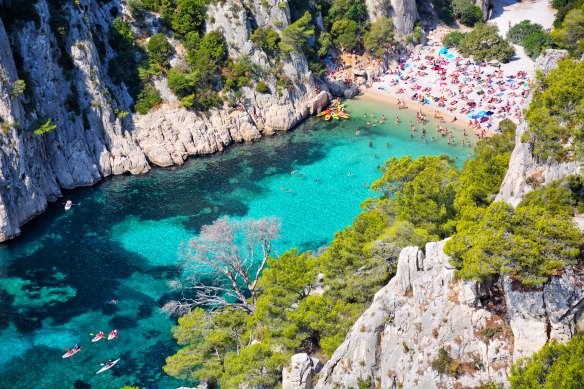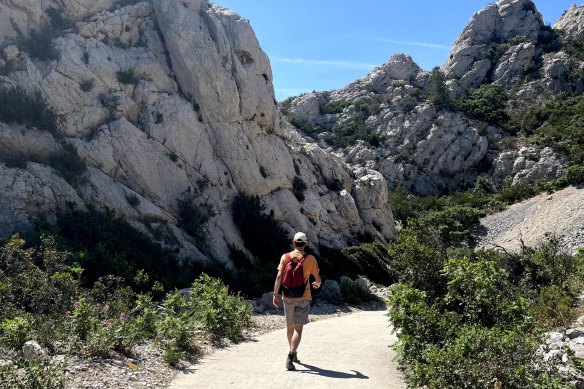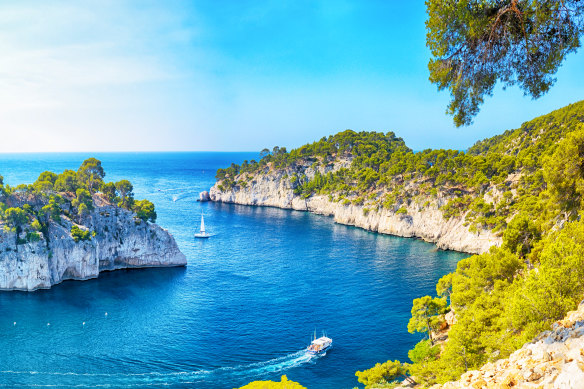Away from the tourist hordes, this might be Europe’s best swimming spot
Viewed from the peak of the 245-metre-high lookout at Sugiton in the Calanques National Park, the colour of the sea is an intense, mesmerising cobalt blue. Beyond the dramatic rise of the 60-million-year-old white sandstone cliffs, a few tiny yachts bob in the distance. Down to my right, I can see Morgiou and the village’s wooden boats. On my left is the sparkling water of a narrow cove formed by millions of years of erosion. After a steep hike down its rocky cliffs, I’ll soon be swimming in its calm, clear water.

The cliffs and beaches of the Calanques National Park are a natural wonder.Credit: iStock
The Mediterranean has no shortage of beautiful locations, but this 20-kilometre coastline wedged between Marseille and Cassis on France’s Cote Bleue is different. No cruise ships are anchored off the shore; jet skis, motor-powered boats and drones are banned; and the only sounds of summer are buzzing bees and the rising chorus of crickets. Even in peak season, when a surge of locals and visitors seek out its fishing villages and swimming spots, crowds are limited. A ballot system, first implemented in 2022, restricts access to Sugiton, the park’s most popular swimming spot, to just 400 people a day in June and September weekends and daily throughout July and August.
France’s newest national park and the only European park with a mix of marine, land, agricultural and urban sections, the Calanques National Park was established in 2012 after a 13-year campaign to protect its fragile flora and fauna from inappropriate development and exploitation. The park’s beautifully maintained trails through Aleppo pine forests and via rocky coastal paths bordered by wild thyme and rosemary are a testament to the campaigners’ vision. With non-intrusive signage, a park app for routes, maps and general information, and carefully controlled car and boat access, it is now a wonderland for naturalists.
A hiker’s paradise
The park is made for hiking, with every trail leading up to a spectacular view or down to the narrow rocky coves that bite deep into the limestone. A few lead down to open beaches, and some to small fishing villages where you can find cafes and kiosks, open on weekends or daily in the summer peak.

Hiking the trails of Calanques National Park.Credit: Justine Costigan
Close to the cliffs, there’s no shade, and it can get hot, quickly. The steep descent down to the water (and then back up again) needs a decent fitness level. Even if you plan to visit one of the villages or beaches with a cafe, taking several litres of water and snacks for walking is essential. Your reward is uninterrupted, expansive views of the Mediterranean and the pleasure of swimming in some of its most beautiful, untouched places.
Although some walks track the coast, many lead inland to the villages bordering the park. Despite the app and a hard copy map, we get lost a few times. Even understanding France’s system of hiking markings isn’t helpful when you don’t know where you are.

Calanque de Port-Miou near Cassis fishing village.Credit: iStock
The park encompasses islands and archipelagos, but in the mainland section, there are 20 calanques alone. Over two days, we hiked Callelongue, tiny La Mounine, and the rocky beach at Marseilleveyre then Sugiton and Morgiou, where instead of a trail, we followed the smell of frying fish to the village’s delightfully rustic restaurant, La Nautique. For our next visit, local friends recommend Calanque d’En-Vau and the lookout at Crete de l’Estret , which offers a panorama of the entire park.
The Calanques by bike
If you’re an experienced mountain biker, tackling the park’s often steep and rocky tracks on an e-mountain bike is a good option: the surge of power just when you need it makes covering substantial distances doable, and the gravel paths offer decent thrills.
We book mountain bikes in Cassis, collecting them from local provider Trolib at the southern entrance to the park. The booking (€45 a person) includes a virtual guide (a phone app) and insurance. Even better, when we arrive at the bike pick-up point, the staff devised a personalised itinerary based on the time we want to cycle, the scenery we are looking for, and whether we want to swim.
Our route takes us straight into wine country, passing by Marsanne vineyards, then through pretty pine forests before a slow climb over rocky paths cut through limestone cliffs. Despite the hot, exposed conditions, every few minutes a gentle puff of cool air rolled over the cliffs, and just when we think we’d never reach the sea, the horizon opens, with views across the Mediterranean and down to the Calanque de Port-Pin.
From there, it is all downhill cycling to the fishing village of Port-Miou and beyond to Cassis’ Bestouan beach where, in classic Riviera style, oil-basted sunbathers bake under the clear blue sky. The final leg of our ride takes us inland to our drop-off point, just in time to head down to Cassis for a portside lunch of local fish.
Calanques by boat
One of the easiest ways to explore is to take a ferry to the Frioul Archipelago, the quartet of islands visible from Marseille’s old port and part of the national park. The ferry’s first stop is If, the setting for Alexandre Dumas’ novel The Count of Monte Christo, but for hiking and swimming you need to continue to Port Frioul, where it’s a short walk to Calanque St Esteve or L’Eoube, secluded rocky beaches sheltered by high cliffs.

Calanques by boat.Credit: iStock
Other local ferries take you south to Les Goudes, a tiny fishing village with a handful of bars and restaurants. It’s one of the starting points to the park’s mainland section; from here, you can walk or take a bus to Callelongue or keep hiking to further coves along the coast.
Beyond using Marseille’s on-water public transport, a boat tour is an ideal way to get a sense of the grandeur of the park’s massive limestone cliffs and see the many small islands and rocky outcroppings off the coast. Several approved providers offer half- and full-day tours to the national park, including the uninhabited Riou archipelago south of Marseille. I take a half-day tour with Eco-Calanques (€90 a person) but many boat tours stop here, as its islands offer sheltered coves ideal for swimming and snorkelling. The water is so clear you can spot large schools of fish from the deck of your boat. As well as the standard tours, you can hire a traditional sailboat (with a captain) to create a personalised itinerary.
The park is a wonderland of marine flora and fauna. You might spot native Neptune grass, a marine plant that’s a feeding ground for fish, including sea bream, seahorses, sea urchins and fan mussels, which can reach up to a metre long. The birdlife is rich too. From the deck of our boat I spot Cory’s shearwaters in the waves and families of shags (unsurprisingly) perched on rocks, while a rare eagle hovered ominously overhead, carefully calibrating its dive for prey.
THE DETAILS
VISIT
Entry to the Calanques National Park is free. The park is easily accessible by public transport (bus or boat), e-bike, car from Marseille, and on foot or bus from Cassis. Summer reservations for Sugiton are free and mandatory and can be checked at the park. Bookings open online three days in advance. See calanques-parcnational.fr/en
FLY/TRAIN
Qantas operates flights to Paris from Sydney, Melbourne, Brisbane, and Adelaide and direct flights to Paris from Perth. See qantas.com
From Paris, take the fast train from Gare de Lyon, arriving in Marseille in just 3 hours and 20 minutes. See sncf-connect.com
STAY
Accommodation within the park is limited to the La Fontasse youth hostel near Cassis, but there is no shortage of guesthouses near the park border or hotels in Marseille and Cassis. Following a three-year renovation, the Intercontinental Marseille-Hotel Dieu reworking of the city’s 18th-century hospital and orphanage has transformed it into a luxury hotel with expansive views of Marseille. Double rooms from €199 ($325). See marseille.intercontinental.com
The writer travelled at her own expense.
Sign up for the Traveller Deals newsletter
Get exclusive travel deals delivered straight to your inbox. Sign up now.